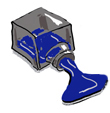
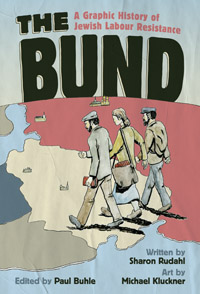
The Bund,
written by Sharon Rudahl, edited by Paul Buhle
2023
Return to home page Return to Projects page
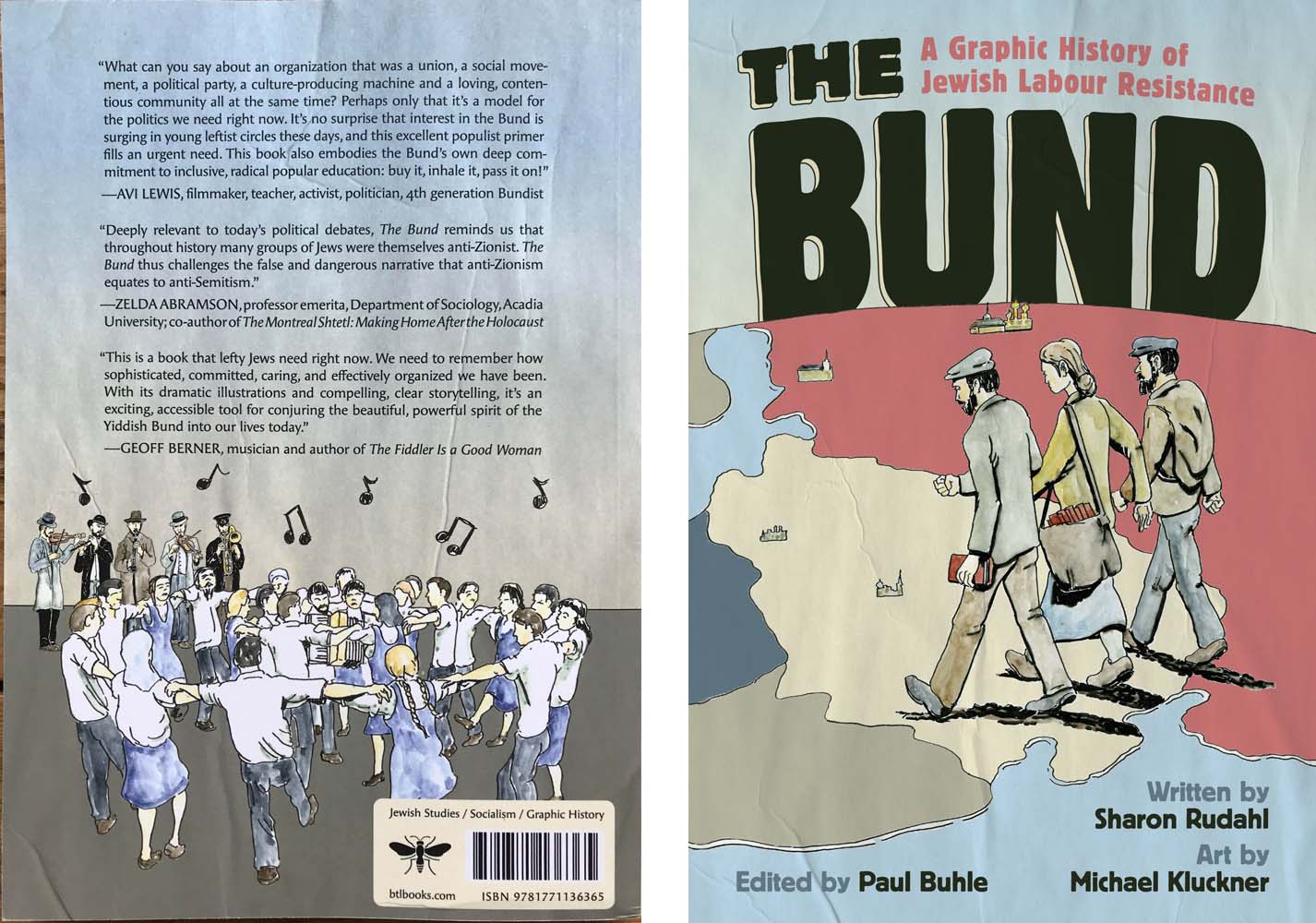
An interesting project for me under contract with Between The Lines publishing in Toronto.
Available in bookstores in Canada, the USA, and (as of November 2023) the UK.
Jewish labour and cultural history that I didn't know really anything about before I started, set in Ukraine, Poland and Russia a century ago.
Here are a few page spreads:
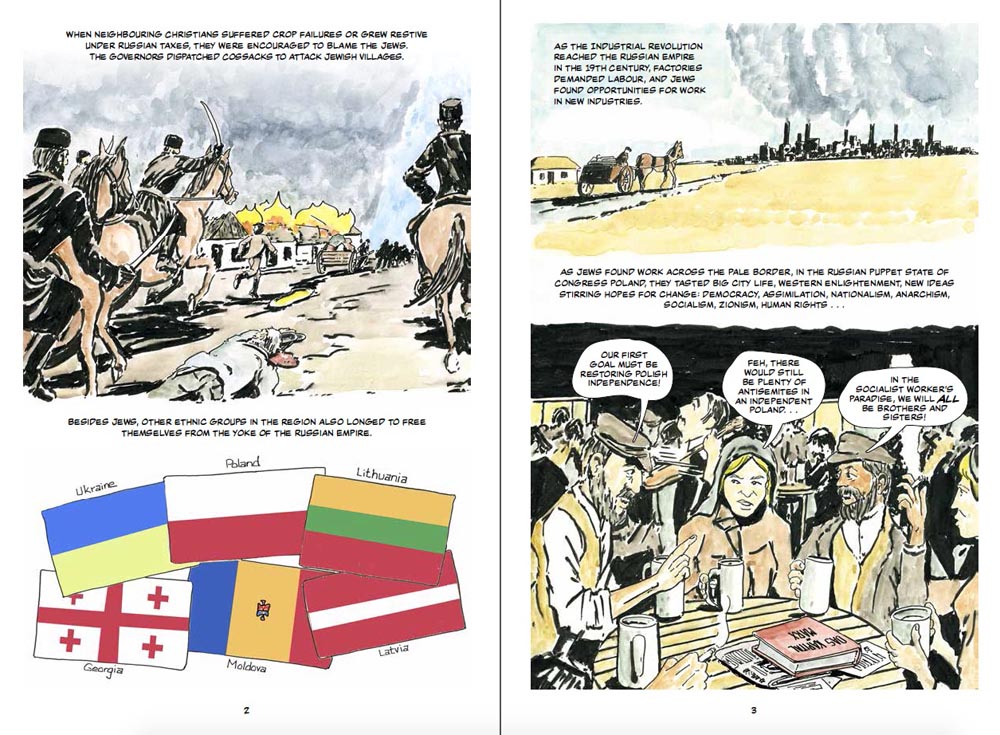
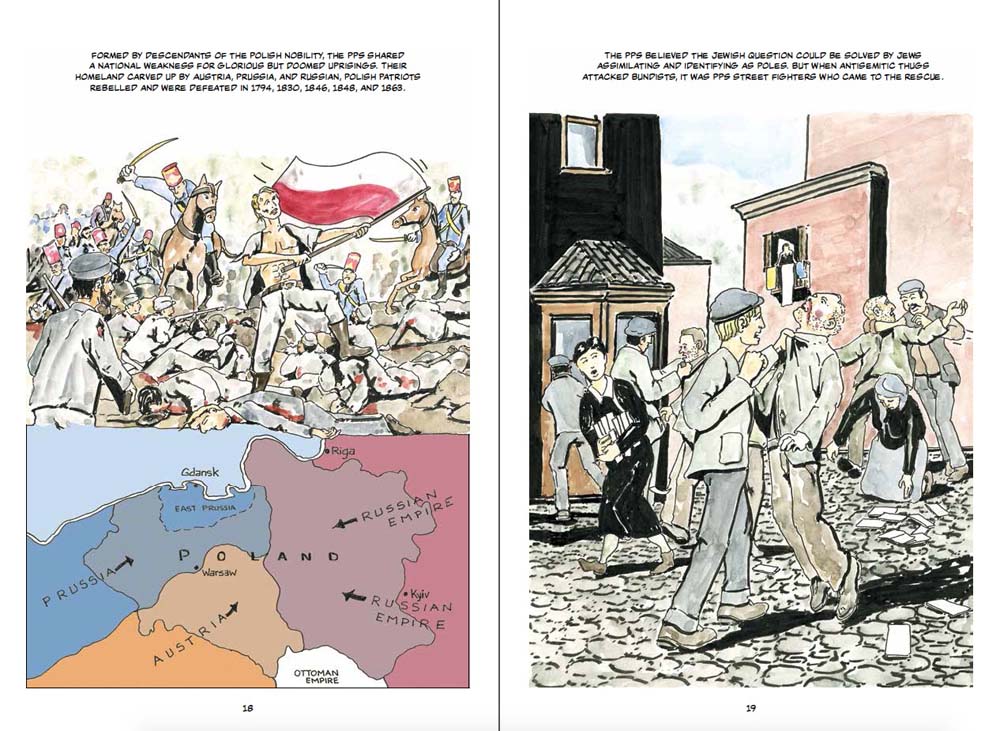
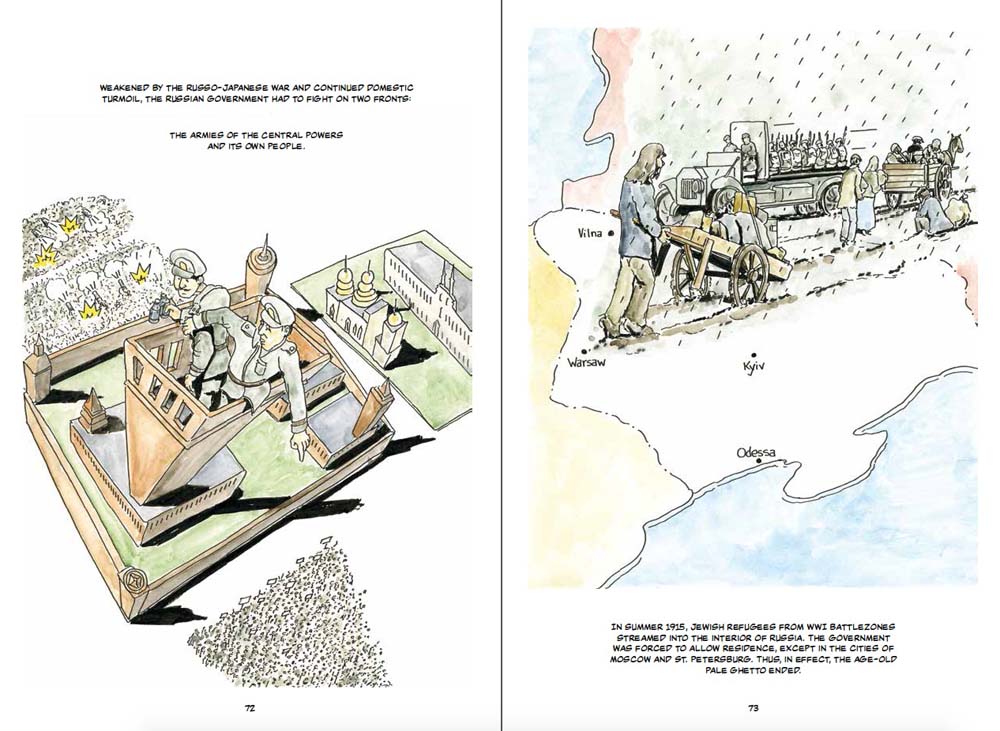
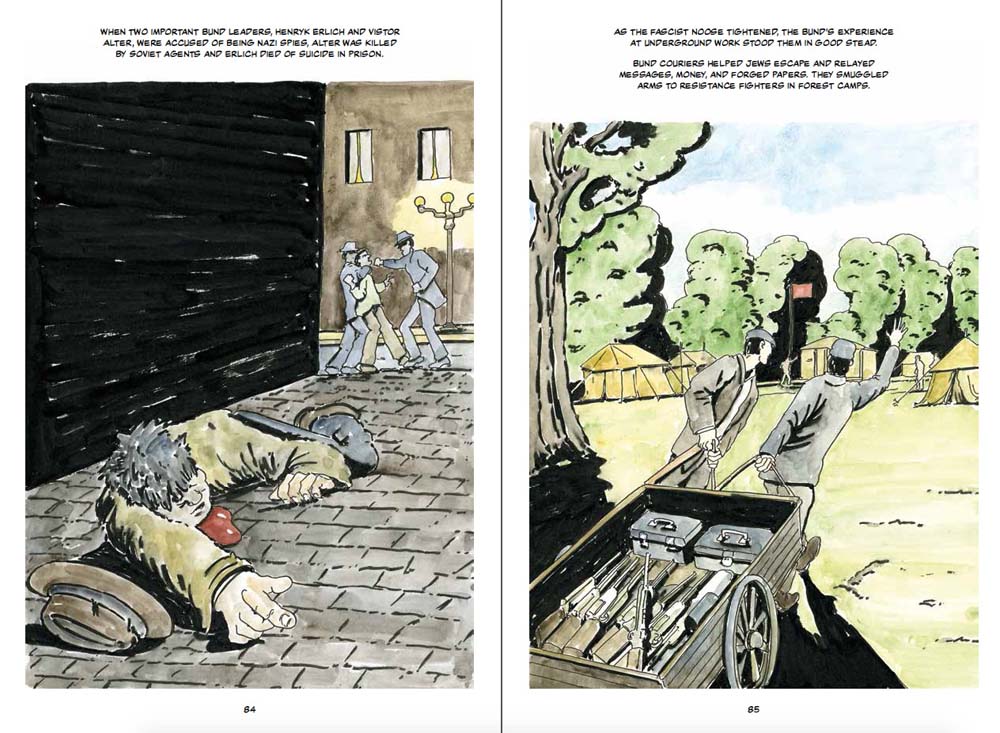
| I worked from Sharon Rudahl's script which was divided down into
scenes, some of which became pages. The idea was to do about 100
pages of illustrations, with chapters starting on a
right-hand-page and the need to stage the narrative so that
particular scenes were double-page spreads. It was a pleasure
working in colour, "colouring-in" over a brush-Chinese ink base
with some fine detail in pen, and I used a sort of "poverty
palette" of ochres, umbers and dull greys (Payne's Grey and Davy's
Grey) in watercolour on Strathmore Bristol "vellum" – a paper that
you're not supposed to use wet media on! The pages with
aristocrats such as the Tsar of Russia got a different palette:
bright blues and reds. I wanted it to look rough – the antithesis
of the smooth digital Pixar-type art that I loathe – and it
worked. And lots of hand-drawn maps, as the geography was so
important, at least to me. |
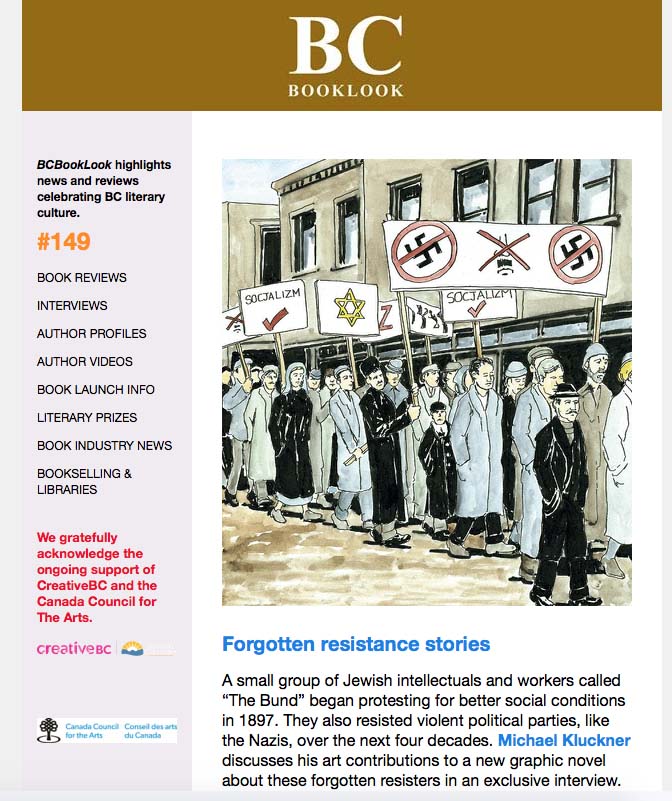
| Interview by David Lester Following up on the success of The Rooming House: The West Coast in the Seventies (Midtown, 2022), Vancouverite Michael Kluckner has illustrated The Bund: A Graphic History of Jewish Labour Resistance (Between The Lines $34.95), written by Sharon Rudahl and Paul Buhle. A virtually forgotten piece of political history, The Bund is an important addition to the canon of graphic literature depicting resistance against tyranny. The Bund was founded in Vilnius in 1897 by a small group of Jewish workers and intellectuals from the “Pale of Settlement” areas in tsarist Russia. Pale of Settlement is an archaic term for places that Jewish people were allowed to reside in. Beyond these borders, Jews were mostly forbidden. The group organized against industrial exploitation and fought against the murderous Soviet and Nazi regimes. Through all this, The Bund kept secular and progressive ideas alive. Prominent Bundists included Pati Kremer (1867–1943), a Russian revolutionary socialist, and Bernard Goldstein (1889–1959) who helped smuggle in arms in preparation for the 1943 Warsaw Ghetto Uprising. The Bund was co-written by Sharon Rudahl, a graphic novelist in her own right, and a key figure in the ground-breaking feminist Wimmen’s Comix, an underground comics anthology published from 1972 to 1992, and Paul Buhle, a veteran of work on almost 30 non-fiction graphic novels. Kluckner’s previous graphic novels are Julia (Midtown Press, 2018); 2050: A Post-Apocalyptic Murder Mystery (Midtown Press, 2016) and Toshiko (Midtown Press, 2015). David Lester: Quite a leap from the West Coast in the 70s to tsarist Russia. Michael Kluckner: The shift in locale and time was interesting. I could say I passed Horse 101 in art school and drew a lot of beards for The Rooming House so I was well-prepared. The image research was fairly straightforward thanks to the Internet. I was able to find photographs (to draw from) of some of the quite minor Bundists as well as the recurring characters like Pati Kremer, Bernard Goldstein, and Lenin of course. The rural Ukrainian and Polish scenes were re-imagined from historic photo sites, and there are photos online of, for example, the tsar’s crown and the Kremlin, which repeat throughout the book in different roles. DL: Your previous graphic novels were in black and white. How was it to work in full colour? MK: I had been playing around, adding some flat watercolour to black-and-white ink drawings like the “woodcuts” in The Rooming House—colouring them in with patches of watercolour rather than really “painting,”—and it worked out very well. I used a kind of “poverty palette” of umbers and ochres, with a couple of dull greys, for the Bundists and peasants, and a brighter palette of blues and reds for the panels of the aristocracy. I also drew quite a number of cartooned maps using digital colour, for example to show the Pale of Settlement in Ukraine / Poland / Russia where Jews were confined. Showing the geography of their oppression was one of the tasks I wanted the book to accomplish. Another thing was figuring out Polish, Yiddish and Russian placards and signs for a few of the pages. I didn’t want any English in the graphics. The publisher had a linguist check all of them, I believe! DL: You normally write and illustrate your own books. What was it like collaborating with the legendary Sharon and Paul? MK: Both were very supportive and Sharon’s script was easy to follow. It became a question of splitting it out into about 100 pages, with the inevitable need to start a chapter on a right-hand page and stage the narrative so that I could use a two-page spread for some important and dramatic moments. Devin Clancy, the production designer at Between the Lines, picked up a few vignettes from drawings and repeated them, even reversed them, on a few pages to enrich the layout. All in all, it was a great collaboration, and so 21st century: Paul’s in the eastern US, Sharon’s in LA, BTL is in Toronto. The first time I saw them was in a Zoom presentation at a San Francisco library in October. DL: Is there a particularly profound moment in the book that stood out to you as a historian and artist? MK: The book is haunted by our knowledge of the pending Holocaust. The Warsaw ghetto scenes were difficult, as was the page almost at the end where the women and children in Vilna (in Lithuania, now known as Vilnius), in sorrow and with dignity, are being forced onto a truck at gunpoint to be driven to an extermination camp. And, of course, Russia had invaded Ukraine (yet again) just a few months before I began work on the book. Learning more about Imperial Russia and the oppression over centuries of its neighbours, Jewish as well as every nationality nearby, was disturbing. I think the couple of pages I enjoyed drawing most were about Japan beating the crap out of Russia in their 1905 war. DL: Any future graphic novels or book projects in the works? MK: I’m going back to the future, as it were, with a book called Surviving Vancouver that will be out next spring. It is like my old works of watercolour illustrations and a text mixing historic and current information. Then I may work on a sequel to The Rooming House—I received so many fascinating emails from people recounting their own lives and adventures in the 70s and thereafter. There are more stories to be told, and the graphic novel format works well. |
Excerpted review in Comics Grinder, September 24, 2023
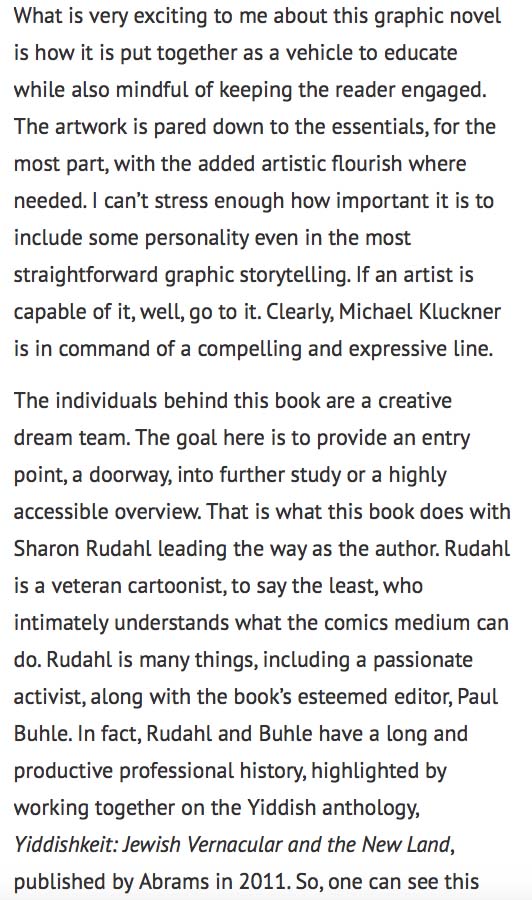
***
Solidarity Across Borders and Time: The Jewish Labor BundSEPTEMBER
28, 2023 by JOEL
SCHECHTER
The Bund: A Graphic History of Jewish Labour Resistance Edited by Paul Buhle, written by Sharon Rudahl, illustrated by Michael Kluckner, with a foreword by David Rosenberg. Between the Lines Press, 2023. (The book can be ordered in Canada at Between the Lines Press and in the United States at AK Press.) A live online interview with the creators of The Bund can be heard on October 22 at the Jewish Community Library. From its beginnings under Russian occupation in Vilna, Lithuania in 1897, the Jewish labor association known as the Bund faced many of the challenges that are still with us: state and factory opposition to labor unions, war in Eastern Europe, tyrants suppressing democratic and socialist movements. The word “bund,” which means “to bind” or “alliance” in Yiddish and German, became the title of an enduring labor and cultural association formed by Jews. (The group’s full title was “The General Jewish Labor Bund of Russia, Lithuania and Poland.”) The history of this group, and its legacy in contemporary political and cultural activism, are celebrated in a new graphic history book that deserves to be celebrated as well. The Bund: A Graphic History of Jewish Labour Resistance, edited by historian Paul Buhle, offers a text written by Sharon Rudahl and illustrated by Michael Kluckner. In subtly colored drawings, Kluckner introduces a bevy of Tsarist soldiers, Bundist organizers, Lenin and the Bolsheviks, farmers, scholars, workers, fascists, and resistance fighters. The men and women in this story almost leap off their pages, as their watercolor and ink images stand out against the white background. While the images are eloquent on their own, Rudahl’s concise and lively narrative moves the reader through a half-century of uprisings, arrests, escapes, suppressed publications, strikes, and underground resistance, along with the cultural and political triumphs that accompanied Bundist activity. Much
of this history has been told at greater length in scholarly
volumes. But The
Bund’s highly visual presentation
offers a new, inviting perspective on the past and its
connection to present-day activism. A graphic history,
much like a graphic novel (minus the fiction), by its very form
calls for a new approach–an approach dependent on visual images,
an approach well suited to an age in which film, television, and
electronic screens often steal prospective readers away from
text-heavy books. The genre of graphic history book, like
the graphic novels that preceded it, should not be confused with
antecedents in comic books and political cartoons. The
Bund is not a comic book, which is to
say the illustrations are not shown in six or eight small boxes
per page, but rather through capacious, mostly full-page
drawings that offer a lot of detail. Humor surfaces at
times in the words and images; but, in general, the presentation
is more panoramic than comic. Before graphic novels gained a respectable following a few decades ago, comic book artists and cartoonists tended to offer readers worlds of fantasy, science-fiction, horror, and romance. Superheroes and talking animals were the most popular characters. A significant change in topics and style began in the 1960s as “underground comix” by such artists as R. Crumb, Art Spiegelman, Spain Rodriguez, and Trina Robbins drew on alternative culture and New Left politics. Spiegelman’s graphic novel Maus proved it was possible to explore extremely serious matters such as Holocaust survival and family tragedy through “comic” art. Paul Buhle has taken the art of graphic book-writing in another, highly adventurous and commendable direction, by editing and commissioning visual histories of radical political figures such as Emma Goldman (in a book by Rudahl), Eugene Debs, Paul Robeson, Che Guevara, and stories about Leftist groups such as Students for a Democratic Society, and now, the Jewish labor Bund. As Buhle notes in his epilogue to the new book, the Bund’s continued existence (and resistance to its adversaries) over decades became a sort of collective memory, “a collective past” that “lies hidden within all of us.” Unknown or underacknowledged by many people, this collective past includes the radical impulses of Jews resisting oppression through organized labor and cultural activities in the first half of the twentieth century, impulses that have resurfaced and taken new form among their descendants and later generations. “The Bund actually found a new if limited role in postwar North America,” notes Buhle, as those in its tradition “took part in a revival of the Yiddish schools, choral, and other activities while extending their resources to help other survivors trapped abroad or recently arrived.” More specific passing along of Bundist tradition is acknowledged in Rudahl’s brief biography of Bundist Charney Vladeck, born in Minsk, an immigrant who became “a Social Democratic giant in New Deal Manhattan.” Current programs in social justice activism and Yiddish cultural history promoted by Workers Circle branches in Canada and the United States can be considered Bund-like actions, with many Bundist immigrants having joined Workers Circle early in the past century. The graphic history’s two most lengthy Illustrated biographies confirm the resistant and enduring qualities of Bundism, as the narrative explains how Bernard Goldstein went from prison in Tsarist Siberia to underground resistance in World War II Poland, and from surviving the Warsaw ghetto uprising to a less trying life in the United States; and how one of the Bund’s founders in Vilna, Pati Kremer, survived several arrests under Russian occupation, and later hosted secret Bund meetings in German-occupied Lithuania. Some of the Bund’s long and hemisphere-spanning life might be attributed to Yiddish, once the vernacular language of Jews across Eastern Europe. Bund speakers could be understood by Yiddish-speaking Jews in many countries, and their shared language made the Bund de facto an internationalist organization (although it favored ethnic autonomy too). Yiddish crossed many borders, and moved with its speakers to North and South America when they immigrated. Of course Bundist ideas can be implemented in other languages, and have been. The Bund by no means limited itself to Jewish or Yiddish culture, either. As David Rosenberg notes in his preface to the book, the Bundists “put great stress on culture – not just Yiddish culture … but also the world of culture that other peoples had created – their art, music, literature, education. Just as the Bund worked for a world without borders, they wanted the borders between cultures to be fluid to enable mutual understanding and appreciation.” The Bund also sought to improve its communities with schools, dances, choral and theatrical performances, sanitaria, and self-defense units. The book makes no reference to the Democratic Socialists of America, but it would not be unreasonable to speculate that the Bund’s advocacy of democracy and socialism, and its resistance to fascism and exploitative capitalism, anticipated some current DSA programs. In fact, Bundists were among some of the early members of DSA’s predecessor organizations. The historic Yiddish labor organization’s influence continues; and after reading this colorful and compelling book, it is hard not to want to celebrate and renew its efforts. |
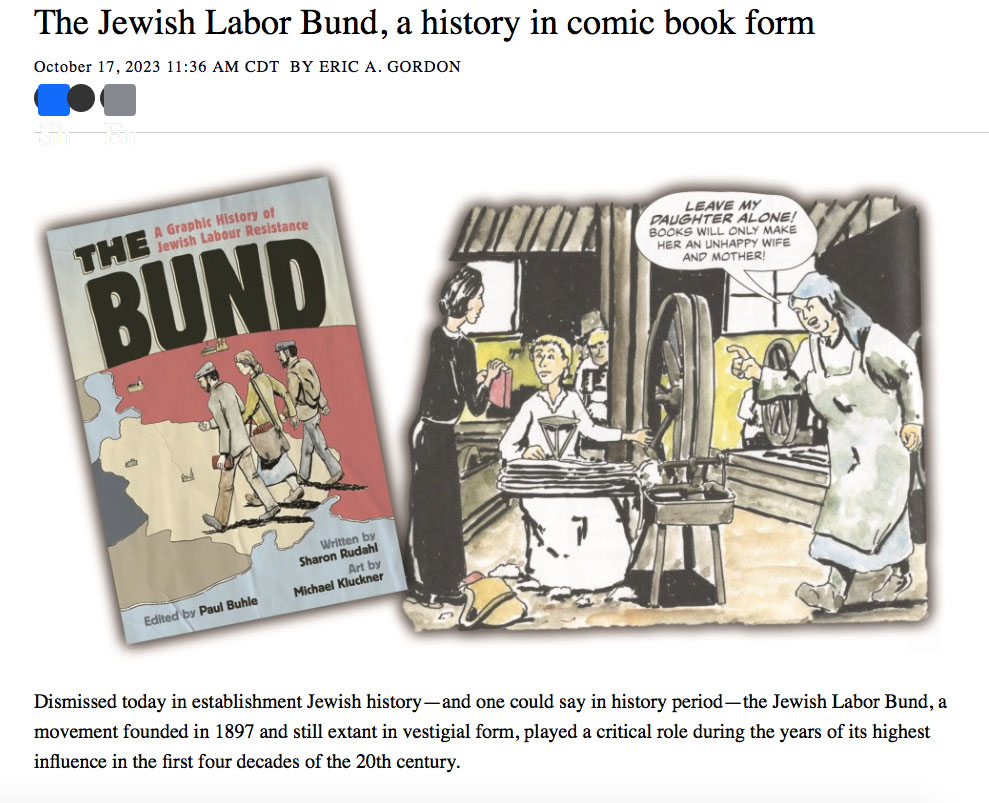
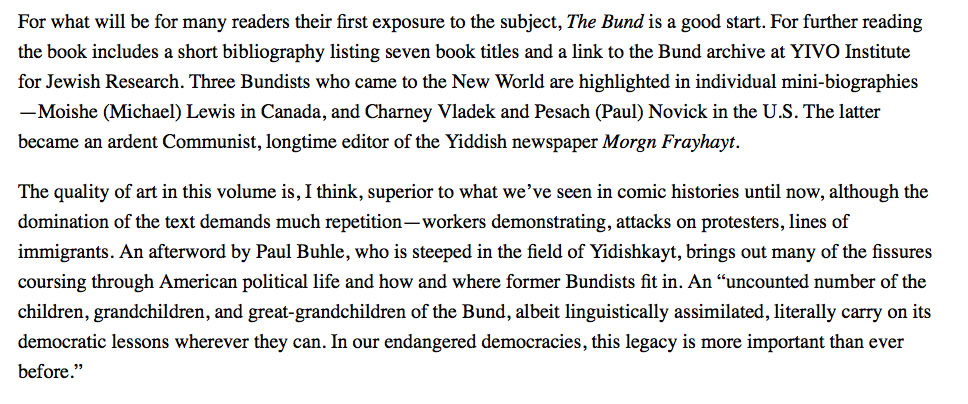
| Richard Kuper writes in a website for left-wing Jews in the
UK: It is, as the title and front cover suggest, a
beautiful comic book history of one of the most powerful
political movements to develop among modern Jewry. Only the Zionist movement could rival it – and it took the Second World War and the Holocaust to enable the triumph of the latter…The book tells its story well with a light-touch, short-dialogue approach and beautiful, sometimes haunting, cartoon illustrations. It has a brief introduction by David Rosenberg of the Bundist-influenced Jewish Socialists’ Group in Britain, and an afterword by its editor Paul Buhle, a veteran of the 1960s Students for a Democratic Society (SDS) and prolific chronicler of the left’s history, often in graphic form. His most recent publication is What Could’ve Happened Here, a graphic novel asking the question, ‘What if the attack on the U.S. Capitol succeeded?’ I wish The Bund were longer than its 120 pages but, alas, producing graphic novels isn’t cheap, and this volume is already relatively highly priced. |
German edition published in 2024
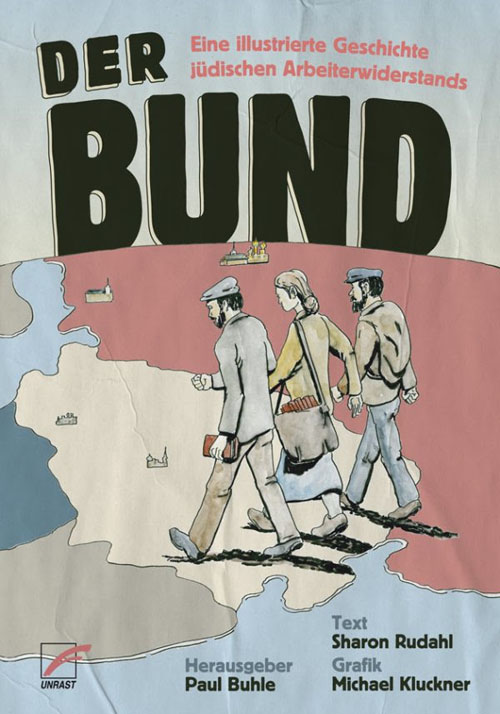
Artwork and text ©Michael Kluckner, for Between the Lines
publishing, Toronto, 2023